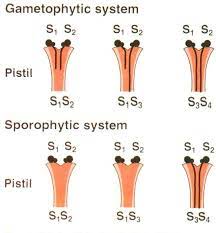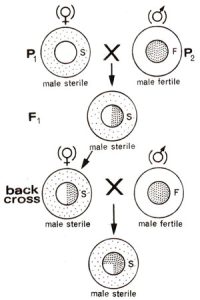Self-incompatibility & Male sterility
Introduction
Self-incompatibility is one of the mechanisms promoting cross-pollination. It is defined as the failure of pollen from a flower to fertilize the same flower or other flowers on the same plant. Here male gamete is fully functional.
In other words, Self-incompatibility (SI) is the inability to produce zygotes after self-pollination in a fertile hermaphrodite plant, which has stamens and pistils in the same flower. This structural organization of the hermaphrodite flower increases the risk of self-pollination, leading to low genetic diversity.
The SI trait can be observed in Brassica crops, including cabbage, broccoli, turnip and radish.
The precise nature of self-incompatibility is not understood, but its occurrence is due to biochemical reaction.
Male sterility simply means the non-functional pollen grains. It is also one of the mechanisms which promotes cross-pollination. Unlike self-incompatibility, here male gamete is non-functional, but female gamete is fully functional.
Male sterility cane be created by spontaneous mutation, interspecific hybridization, mutation induction, genetic engineering and by chemicals.
Male sterility speeds up the hybridization programme, reduced the cost of hybrid seed production, avoid hard manual work of emasculation and pollination. It is used for production of large scale of F1 seeds and commercial exploitation of hybrid vigour.
Types of Self-incompatibility
In case of Self-incompatibility, any how embryo does not develop. It means, self-incompatible pollen grains do not germinate and if pollen grains germinate, its pollen tube fails to enter into stigma. And, if pollen tube enters into stigma and fertilization take place, embryo aborts.
(A) SI is classified morphologically into:
- Heteromorphic SI: Flowers of different incompatibility groups are different in morphology. Heteromorphic SI is related to different flower shapes; for example, pin (long pistil and short stamen length) and thrum (short pistil and long stamen length) forms are present in primrose (Primula species), buckwheat and star fruit (Averrhoa species). Cross pollination between different flower types is compatible and is regulated by a single locus with two alleles, S and s. The genotype of pin is ss homozygote, and that of thrum is Ss Thus, on cross-pollination, a frequency of 50% each of pin and thrum should be maintained in a wild population under SI regulation. Interestingly, this S gene controls both the incompatibility phenotype and the flower shape (that is length of pistil and stamens).
- Homomorphic SI: Homomorphic SI species have a single flower shape and are classified by the inheritance pattern of the S gene into gametophytic SI and sporophytic SI. Both SI phenomena are controlled by a single locus, with multiple S alleles (S1, S2, S3, … Sn) in most of the plant species. The incompatible phenotype is apparent in self-pollination and in cross-pollination between pollen and stigma of two different plants carrying the same S.
Gametophytic & Sporophytic Sytem
In Gametophytic SI (GSI), the S phenotype of pollen is determined by its own haploid S gene. The self-pollen inhibition occurs during pollen tube elongation in the style of the pistil in most GSI. Plant species in families Fabaceae, Onagraceae, Poaceae, Rosaceae, Plantaginaceae and Solanaceae exhibit GSI.
The incompatibility reaction of pollen is determined by its own genotype and not by the genotype of plant on which it is produced. Example: pineapple, rye grass, diploid coffee, diploid clovers, etc.

In Sporophytic SI (SSI), the S phenotype of pollen is determined by its parental diploid S gene interaction, so that dominance relationships occur between S alleles. In most SSI plant species, from families Asteraceae, Brassicaceae and Convolvulaceae, pollen tube inhibition occurs on the stigma surface.
The incompatibility reaction of pollen is determined by the genotype of the plant on which the pollen is produced and not by the genotype of the pollen. Example: parthenium argenteum.
(B) Based on interaction between pollen grains and pistil
- Complementary or Stimulatory type: Here pollen and pistil stimulate each other or either. Example: Dendrobium.
- Oppositional or Inhibitory type: Here pistil and pollen inhibit each other or either. Almost all the cases of self-incompatibility is are inhibitory type.
Types of Male Sterility
Male sterility is characterized by non-functional pollen grains, while female gametes functions normally. Main reason is mutation.
Manifestation of male sterility are absence or malformation of male organs, inviable pollen, abnormal pollen maturation etc.
Male sterility can be grouped into:
- Genetic male sterility (GMS)
- Cytoplasmic male sterility (CMS)
- Cytoplasmic genetic male sterility (CGMS)
- Chemical induced male sterility
Whether a particular sterile genotype belongs to which MS system can be detected by its progeny performance on crossing with a few normal genotypes.
- CMS: All progenies in all the rows may be sterile.
- GMS: some row may consist all fertile some rows sterile and fertile in 1:1 ratio.
- CGMS: some rows fertile. Some rows sterile and some rows sterile and fertile in 1:1 ratio.
Classification of Male Sterility (Kaul, 1988)
Phenotypic male sterility (Morphological)
- Pollen sterility: in which male sterile individuals differ from normal only in the absence or extreme scarcity of functional pollen grains.
- Structural or staminal male sterility: in which male flowers or stamens are malformed and nonfunctional or completely absent.
- Functional male sterility: in which viable pollen is trapped in indehiscent anther and thus prevented from functioning.
Genotypic male sterility
- Genetic male sterility (GMS): Also called as nuclear male sterility and mostly governed by single recessive gene ‘ms’ but also by dominant gene (safflower). GMS originated from spontaneous mutation or artificial mutation (Gamma rays, EMS).
Mutagens Crops Colchicine Jowar Ethidium Bromide Groundnut, wheat, maize Acetone Barley
GMS may be environmental sensitive (Thermo sensitive GMS, photoperiod sensitive GMS) or environmental insensitive (‘ms’ gene expression is much less affected by the environment). In TGMS, complete male sterility is produced by the ‘ms’ gene at particular temperature e.g. 230C for rice TGMS line Pei-Ai645. It is used in China to develop hybrid rice. PGMS is governed by two recessive genes, sterility is obtained in long day conditions (13 hrs. 45 mins + Temp. 23-29oC) but fertile under short day conditions.
Cytoplasmic male sterility (CMS)
Governed by cytoplasm (mitochondrial or chloroplast gene). CMS is result of mutation in mitochondrial genome (mtDNA) leads mitochondrial dysfunction. Progenies are always male sterile because cytoplasm comes primarily from female gametes only. Nuclear genotype of male sterile line is almost identical to that of the recurrent pollinator strain. Male fertile line (maintainer line or B line) is used to maintain the male sterile line (A line). CMS is not influenced by environment hence is stable. CMS is used in hybrid seed production of certain ornamental species where vegetative part is of economic value. But not for crop plants where seed is the economic part because the hybrid progeny would be male sterile. CMS is found in onion, cabbage, fodder jowar etc.

Cytoplasmic genetic male sterility (CGMS): It is the case of CMS where a nuclear gene (R) for restoring fertility in male sterile line is known is called CGMS. The fertility restorer gene (R) is generally dominant which restore male fertility in the male sterile line. This system is known in cotton, maize, Bajra, sunflower, jowar, rice and wheat.
Transgenic male sterility (TMS): Recombinant DNA techniques for disturbing any or number of developmental steps required for the production of functional pollen within the microspore or for the development of any somatic tissues supporting the microspores. Transgenes for male sterility are dominant to fertility. It is also used to develop effective fertility restoration system for hybrid seed production.
Chemically induced male sterility (CHA): CHA is a chemical that induces artificial, non-genetic male sterility in plants so that they can be effectively used as female parent in hybrid seed production. Also called as male gametocides, male sterilant, pollen suppressants, pollenocide, androcide etc. Example: Maleic Hydrazide (MH), Ethephon, Mendok, Gibberellic acid etc.